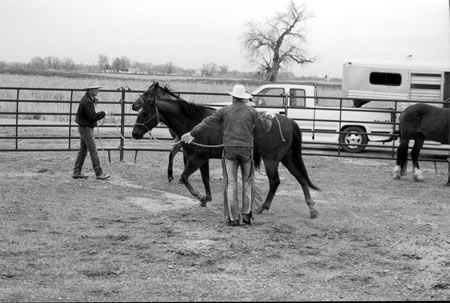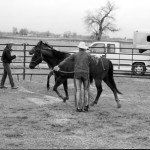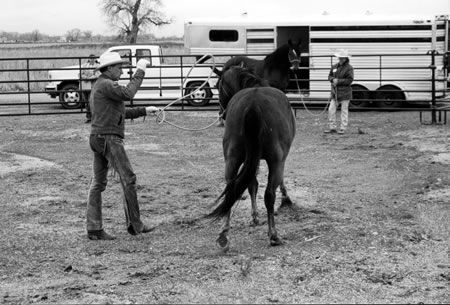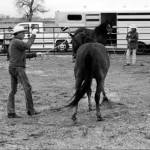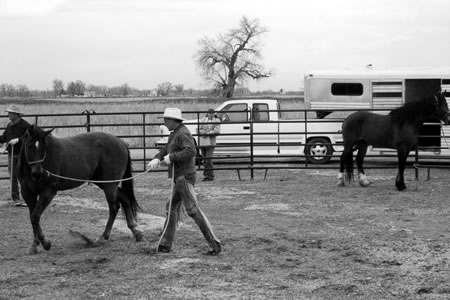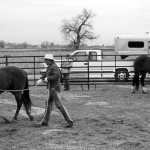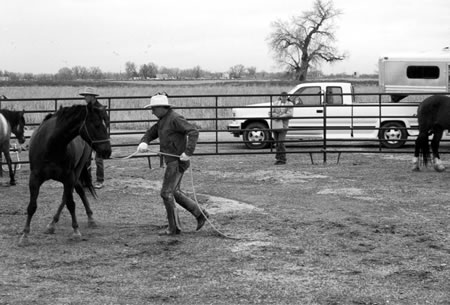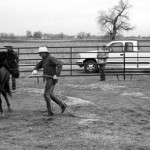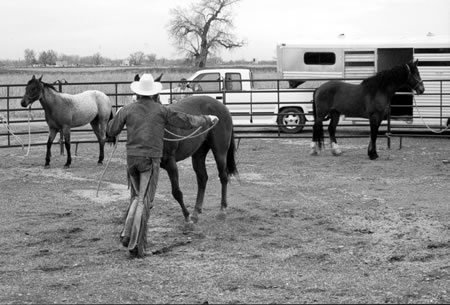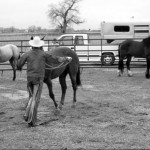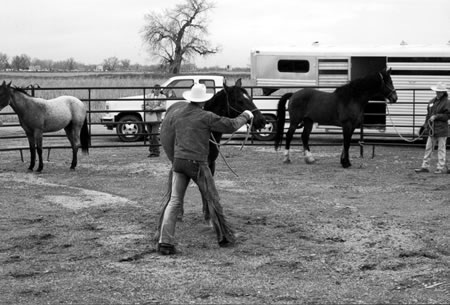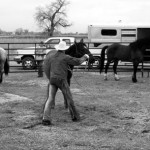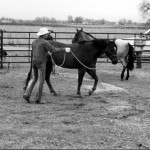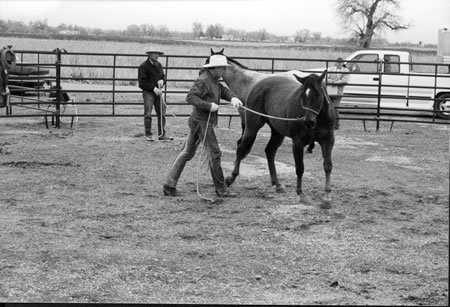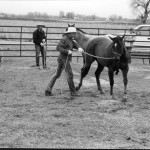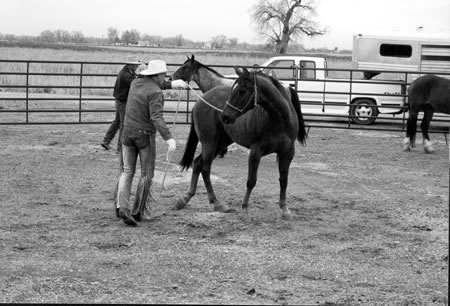Fundamental Horsemanship
Getting Off On The Right Foot
With Buck Brannaman photos by Emily Kitching
This article originally appeared in Eclectic Horseman Issue No.1
“By working on driving your horse past you and changing directions, you will establish influence over your horse’s feet. If you can gain some from the end of the halter rope when you are on the ground, then you’ve got a good chance of con- trolling your horse when you get on their back,” says Buck Brannaman. “But if you can’t lead them with any kind of accuracy, you won’t have much luck riding them.”
Buck was addressing his colt class at a clinic in Colorado.
The following series of photos of Buck and his horse Vaquero illustrate the basic components of groundwork. These maneuvers are helpful for young colts and seasoned saddle horses alike as is the foundation upon which you build all communication with your horse. These are the first few steps of what can be an intricate dance with your horse. In future issues we will build upon this introduction.
In this segment of the groundwork you are going to be working on driving your horse to the left and to the right, disengaging the hindquarters and leading the front quarters across. To accomplish these things, you will need to shift your horse’s weight forward and back and direct all four feet. In order for him to move his hindquarters freely, his weight must be on his front feet, and to move the front quarters, his weight must be rocked back onto his hindquarters. By being on the ground, you will be able to see what is taking place with your horse’s feet and weight so that you can more easily feel what is happening when you are on his back.
Be consistent in your body language so that your horse will learn to prepare to move in response from your body lan- guage and not be dependent upon the lead rope.
Groundwork is preparation for riding, so be vigilant in keeping your horse’s feet moving lively and accurately. Imagine what you would like his circles to look like when you are on his back and work toward that goal. At first this might feel awkward and com- plicated to you both, but once you get the hang of the maneuver, it will flow like a graceful dance step.
To start, you will be asking your horse to travel in a circle to the left. Position yourself behind your horse’s left shouder, at least arm’s length from his body. Picture yourself standing at the apex of a triangle, with your horse forming its base. Your left hand will be your leading hand, and your right
hand will be your driving hand. Be sure and keep enough slack between your leading hand and your horse’s head so that you are not interfering with him traveling in a circle. There should also be a good amount of rope left between your dri- ving hand and the tail of the rope, as you will be putting it to use when you ask him to go.
To begin, you will use your leading hand to direct your horse forward by lifting it up and to your left. Take the slack out of the lead rope and apply pressure forward. Then, with your driving hand, swing the tail of your lead rope overhand toward his hindquarters. If your horse resists moving forward, you might need to tap him on the rump with the tail of the rope to get his feet moving. Drive him in a circle around you; be aware of your body position.
“As you drive your horse, it is very important that you stay behind his shoulder so that you use your natural ability to drive him from that position. If you are ahead of the shoul- der, you block him from moving forward,” says Buck.
While your horse travels around you, take the opportuni- ty to get him used to the feel of the halter rope up on his back. Toss it underhand, and let it fall onto his bare back or, if he’s saddled, up on the saddle. This will expose your horse to the new sensation and build his confidence in you. At first it might be shocking to him, but he will soon learn that it is nothing to fear.
“I want your horse to be able to walk around you in a cir- cle with an arc in his body, one that follows the contour of the circle. His nose should be tipped slightly to you. If his nose is tipped to the outside of the circle, give a little tug with your leading hand. Not too much of a tug or he might think you want him to change directions, just enough to bring his nose to the inside,” says Buck.
When the circle is shaping up well, you are ready to change directions. To initiate the change, you need to disen- gage your horse’s hindquarters by asking his inside hind leg to track under and in front of his outside hind foot.
To prepare, you must switch your hands on the lead rope.
Drop the rope from your driving hand, and reach across your body and take ahold of the rope just above your leading hand. Pull the rope through your left hand and let it slide through to put the same amount of space between your two hands as you had before.
Next, step toward your horse’s hip. You are using your body position to push the hindquarters over and yield away from you. You may need to lift your hand a little toward his hip and even bump upward to encourage his feet to step over. You are looking for the hindquarters to step over to the out- side of the circle that he was traveling on.
Once his hindquarters have swung over, he should be fac- ing you. He is now in position to yield the front quarters and change directions. Open your right hand until it is fully extended to your right. Advance toward his right shoulder, asking him to shift his weight back onto his hindquarters and step his front quarters to your right. You may need to advance toward his right eye or even tap him on his right shoulder with the tail of your rope.
Once he has yielded his front quarters, he should be in a right circle and you should be in position to keep driving him past you. Now you can repeat disengaging the hindquarters and bringing the front quarters across on this side until you can flow back and forth from each circle.
During the dance, if you get lost, keep these three words in mind: advance, pause, advance. You are going to advance toward the hindquarters, pause and let his head pass in front of you, and then advance again toward his front quarters.
Let’s follow Buck and Vaquero from a left circle to a right circle and back again.
Helpful Hints
- If your horse doesn’t step over when you ask for his hindquarters, tap him with the tail of your lead rope. He should step forward and through.
- Your horse should keep a bubble of space between himself and you. Use your lead rope, or block him with your leading hand by his eye if he is pushing in on you.
- If your horse has trouble moving forward and is getting stuck in his feet, don’t pull harder with your leading hand. Step behind his shoulder and drive him forward.
- When working your horse around you, be aware that you are not stepping back. This would encour- age a horse to crowd you.
- When you are using your lead to drive, swing it overhand. If you are tossing it up on his back, toss it underhand so that it lands softly on his back.
- Your leading hand directs your horse. You will lift it to show him where you want him to go before you drive him forward.
- Make sure you switch your hands as you ask for the hindquarters. If you haven’t switched your hands, you will be behind when the moment comes to move the front quarters.
- As you work your horse around you, imagine that you are riding him. Don’t be satisfied for dull or inaccurate circles.
- Be careful not to pull on your horse’s head with your leading hand. Give him enough slack in the lead rope so that he can move around you unhindered.
- If your horse is sticky behind, you might need to make a full circle until those feet break loose and start moving. Once your horse gets the idea, you will ask for 90 degrees with the front and 90 degrees with the hind, but to start, you might need to do more.
This article originally appeared in Eclectic Horseman Issue No.1



